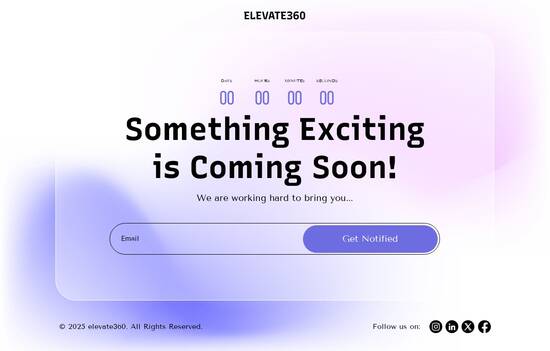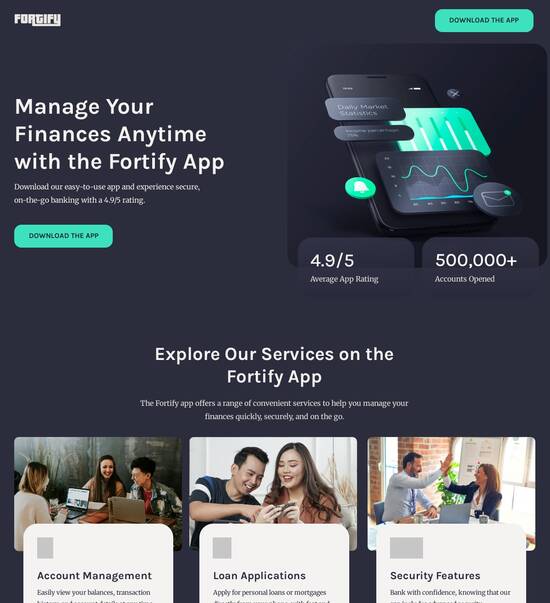
Website template for Design directors
Explore Similar TemplatesAbout template
Achieve your online goals with the website template for Design directors.
Recommended templates

Easy to build without coding
With the intuitive drag-and-drop builder, anyone on your team can create high-converting pages without any knowledge of code or design. Make enhancements to your landing page with custom widgets using Javascript, HTML/CSS, or third-party scripts.

Multiple layouts for any industry and goal
Select from 500+ landing page layouts built to boost conversions across industry-specific scenarios. Customize them by adjusting fonts, adding images, and generating on-brand content with the AI assistant. Quickly scale with Instablocks® and Global Blocks that you can save, reuse, and update globally.

Loads fast and looks polished on any device
Every template is responsive, which means they present professionally on any device and load blazingly fast with our Thor Render Engine. You can also power them up with Google AMP technology to deliver an unparalleled mobile experience and drive higher conversions.

Robust analytics & experimentation
Get real-time updates and reporting across all your devices, showing the number of visitors, conversions, cost-per-visitor, and cost-per-lead. Launch AI-powered experiments, run A/B tests, and use heatmaps to analyze user behavior, then optimize your landing page to maximize conversions.







Easy to build without coding
With the intuitive drag-and-drop builder, anyone on your team can create high-converting pages without any knowledge of code or design. Make enhancements to your landing page with custom widgets using Javascript, HTML/CSS, or third-party scripts.
Multiple layouts for any industry and goal
Select from 500+ landing page layouts built to boost conversions across industry-specific scenarios. Customize them by adjusting fonts, adding images, and generating on-brand content with the AI assistant. Quickly scale with Instablocks® and Global Blocks that you can save, reuse, and update globally.
Loads fast and looks polished on any device
Every template is responsive, which means they present professionally on any device and load blazingly fast with our Thor Render Engine.
Robust analytics & experimentation
Get real-time updates and reporting across all your devices, showing the number of visitors, conversions, cost-per-visitor, and cost-per-lead. Launch AI-powered experiments, run A/B tests, and use heatmaps to analyze user behavior, then optimize your landing page to maximize conversions.
All the features you need to build lead-generating landing pages
Explore more featuresLearn how to build top-performing landing pages for any goal
FAQs
Leading the way in building high-performing landing pages





A comprehensive guide to using Instapage for effective landing page creation
Instapage stands out as a premier landing page and conversion rate optimization (CRO) platform, especially for marketers in dynamic sectors like business services, tech, and education. With its robust set of features and 100+ ready-to-use templates, Instapage empowers teams of any size to accelerate their marketing efforts without a hefty budget or extensive technical know-how.
Benefits of using Instapage for landing pages
Understanding the unique advantages of Instapage can facilitate more successful campaigns. The platform offers unparalleled flexibility and powerful optimization tools that cater to diverse marketing needs. Here are notable benefits:
- Rapid page creation: Leverage 100+ conversion-focused templates and intuitive builders to launch landing pages without needing developer skills.
- Enhanced optimization: Use integrated A/B testing and detailed heatmaps to refine pages for improved conversion rates.
- Personalized experience: Create tailored content for specific audience segments through dynamic text and AdMaps.
Step 1: Setting up your first landing page
To kickstart your journey, consider these foundational steps for creating a compelling landing page:
- Choose a template that fits your campaign goal — select from the extensive library for various industries.
- Customize your content and visuals — use Instablocks to easily modify elements and keep your brand's look consistent.
- Incorporate lead generation elements — add forms and call-to-action buttons strategically to capture information.
Step 2: Optimize for conversions
Once your page is live, the next step is to harness optimization features:
- Utilize A/B testing options — run experiments to determine which versions of your page perform better.
- Analyze heatmaps to see where users engage most — adjust layout based on insights gathered.
- Regularly check analytics for performance metrics — identify drop-off points and enhance user experience.
Step 3: Collaborate effectively with your team
Effective collaboration is crucial in your marketing efforts. Leverage Instapage's collaboration features to streamline workflows:
- Provide feedback in real-time — easily share comments within the platform for immediate revisions.
- Invite external stakeholders to review your pages — maintain security while promoting feedback.
- Conduct team reviews — collaboratively assess the performance of landing pages to ensure goals are met.
In conclusion, using Instapage can significantly enhance the effectiveness of your marketing campaigns through its comprehensive features that cater to both experienced marketers and newcomers alike.
Ready to transform your digital marketing efforts? Sign up for Instapage today and start maximizing your ROI with high-converting landing pages.
People also ask about Website template for Design directors
Website templates for design directors: streamlining creative processes
Understanding the role of website templates for design directors
Design directors play a pivotal role in overseeing web projects, ensuring that creative visions align with business goals. Their unique needs often encompass managing team dynamics, presenting concepts to stakeholders, and maintaining the integrity of brand identity throughout the design process. As they juggle multiple projects, they require tools that not only facilitate creativity but also enhance efficiency.
Website templates emerge as essential resources that address these challenges head-on. By providing a predefined structure, templates streamline design workflows and help with project management. Furthermore, they reduce the time spent on repetitive design tasks, enabling design directors to focus on more strategic aspects of their work, such as conceptualizing new ideas and troubleshooting issues.
Another crucial aspect of using templates is brand consistency. Templates ensure that all web projects maintain a uniform look and feel that aligns with the organization's branding guidelines. This not only reinforces brand identity but also fosters trust with users, as they encounter a cohesive experience across different web touchpoints.
Key features of effective website templates
When selecting a website template, several key features stand out as critical for enhancing the work of design directors. An effective template should prioritize responsive design, ensuring that web pages adapt seamlessly across multiple devices. Mobile responsiveness is vital since an increasing number of users access websites via smartphones and tablets. Failing to account for this can lead to frustrating user experiences and high bounce rates.
Responsive design: Templates should automatically adjust content layout for various screen sizes.
Customizable elements: Flexibility in features like color schemes and typography supports diverse branding needs.
Integrated design tools: Built-in tools simplify edits and contribute to a smoother creative process.
Responsive design not only caters to user-friendly experiences but also aids in SEO efforts, as search engines prioritize mobile-friendly sites in their rankings. Additionally, customizable elements enhance the template's adaptability for different projects, making it easier for design directors to align designs with specific client needs or brand identities.
The role of integrated design tools cannot be underestimated either; these tools, which might include pattern libraries and spacing guidelines, enhance the user-friendliness of templates. They empower design directors to make adjustments without navigating complex coding, making web design more accessible regardless of technical expertise.
Advanced capabilities for enhanced functionality
Effective website templates not only include essential features but also advanced capabilities that enhance user interaction. Built-in functionalities such as form handles and interactive elements significantly elevate the user experience and contribute to engaging web design. These features are particularly important for design directors who want to create memorable user journeys across their websites.
Functionality integration: Incorporating built-in functions increases interactivity with users.
Implementing iolazy: Lazy loading improves image loading times, enhancing overall site performance.
Using document.addeventlistener: This technique improves interactivity by adding responsiveness to page elements.
Using concepts like iolazy for efficient image handling can significantly boost site performance, reducing loading times and improving user engagement. By loading images only when they're in view, design directors can create faster, more responsive websites that cater to user expectations for speed.
Meanwhile, leveraging 'document.addeventlistener' can greatly enhance the interactivity of landing pages. This approach allows design directors to respond quickly to user actions, making websites more dynamic and engaging. Best practices involve setting up event listeners for buttons, links, and other interactive elements, giving the website a polished, responsive feel.
Navigating the user experience lifecycle
User-centric design is at the heart of every successful website, and website templates can play a significant role in crafting such experiences. Design directors can employ templates to simplify user research and develop designs driven by personas, ensuring that the final product resonates with the target audience. Templates often come with accessibility features that help comply with best practices in inclusive design, making them suitable for a diverse user base.
Moreover, templates facilitate effective content management. They help organize and optimize content layout, guiding design directors in aligning information with user behavior. By utilizing templates, design directors can create content-rich experiences that are not only visually appealing but also strategically aligned with user needs.
A well-structured template allows for easy editing and rearrangement of content, which is essential as user preferences and behaviors continue to evolve. The combination of accessibility and strategic content management can significantly enhance user satisfaction and engagement.
Optimizing templates for SEO and performance
While aesthetic appeal is important, the functionality of website templates must also include an SEO focus. Incorporating SEO best practices, such as relevant meta tags and structured data, should be a priority for design directors. Key elements to ensure SEO-friendliness include the use of optimized title tags, alt attributes for images, and an organized URL structure.
SEO best practices: Include meta tags, schema markup, and alt attributes for improved search visibility.
Performance optimization techniques: Code should be streamlined for faster load times.
Use of tools and plugins: Leverage resources that enhance speed and provide analytics insights.
In addition, performance optimization is critical for enhancing user experience. Design directors should prioritize streamlined template code that minimizes loading times. Utilizing tools and plugins can facilitate speed optimization efforts while offering analytics integration to gain insights on user behavior. By focusing on both SEO and performance, design directors can create websites that not only attract visitors but also convert them into loyal customers.
Evaluating template providers: what to look for
Choosing the right template provider is essential for achieving long-term success with website templates. One crucial factor is the provider's reputation in the industry, which can be gauged through user reviews and case studies. A reliable provider should have a proven track record of delivering quality solutions that meet client needs effectively.
Provider reputation: Look for positive user reviews and success stories.
Support and resources: Opt for providers with robust customer support and accessible resources.
Community engagement: Seek a template community that provides regular updates and peer support.
Additionally, the level of support and resources available is vital for designers. A provider that offers ongoing customer support can significantly impact how quickly design directors can troubleshoot issues and make necessary adjustments. Community engagement is also an asset; an active template community fosters collaboration and provides excellent educational resources that can enhance the overall design process.
The future of website templates in design strategy
The landscape of web design continues to evolve, and emerging trends are shaping how templates are used. As technology advances, we can anticipate shifts in the role of templates within design processes. For instance, the integration of AI and machine learning technologies could revolutionize template customization, allowing for more intelligent design solutions that cater to specific user behaviors.
Moreover, sustainable design principles are gaining traction, and templates must adapt to reflect this shift. Design directors should prioritize eco-friendly web practices that promote sustainability by employing templates designed with minimal environmental impact in mind. This focus not only aligns with broader corporate social responsibility goals but can also enhance brand reputation among increasingly eco-conscious consumers.
Case studies: success stories of design directors using templates
Several case studies illustrate the significant benefits that templates can offer design directors. One exemplary project involved the rapid launch of a digital marketing campaign where using a pre-designed template allowed a design team to complete the project in record time. This efficiency not only saved costs but also enabled the team to allocate resources to developing creative strategies.
Notable examples: Projects reflecting how templates contributed to design success.
Impact analysis: Assess the effect of template design on project timelines and outputs.
Additionally, lessons learned from these projects often revolve around overcoming initial hesitations about templates. Design directors discovered that while templates can sometimes feel restrictive, a strategic approach to customization enabled them to achieve their design visions effectively. By allowing for clear guidelines and iterating based on feedback, templates ultimately resulted in high-quality outcomes.
Ready to skyrocket conversions?
Supercharge your ad campaigns with high-performing landing pages
Get started














